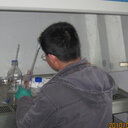The Antioxidation of Different Fractions of Dill (Anethum graveolens) and Their Influences on Cytokines in Macrophages RAW264.7.
Keywords
Abstract
Dill (Anethum graveolens L.) has been shown strong antioxidative and immune propertise, but the precise potency and action mechanisms remain largely elusive. This study is to dissect the different fractions' antioxidant power and antiinflammatory function. We extracted 4 fractions from China original dill with ether (DI-E), ethyl acetate (DI-EA), n-butanol (DI-B) and water (DI-W), and performed 4 different kinds of antioxidative analysis together with vitamine C (Vc): DPPH, ABTS, reducing power and TPTZ-FRAP. For correlated compounds in antioxidant assays Folin-Ciocalteu's analysis was performed. For antiinflammation, cell proliferation by MTT, NO molecules and interleukin-1 and 6 in supernatant were detected by Griess reaction and Elisa, respectively, and gene expression of inducible nitric oxide synthase (iNOS) was analyzed by RT-PCR. The strength of antioxidant activity was Vc > DI-EA > DI-B > DI-W > DI-E. Folin-Ciocalteu's analysis showed that antioxidant power was correlated to phenolic compounds. However, in antiinflammatory assays DI-E was most active one by cell proliferation, iNOS's gene expression, and secretion of interleukin IL-1 and 6 in macrophage RAW264.7. The antioxidant fraction and antiinflammatory fraction of the dill were determined. The certain fractions of dill may be strong at antioxidation, but weak at antiinflammation, vice versa. Thus dill has anti-ageing and anticancer potential, a good resource for functional food and ancillary drugs of rehabilitation.



